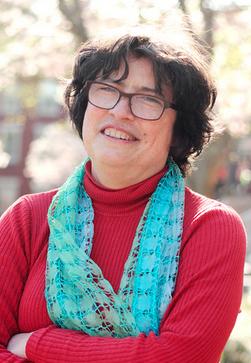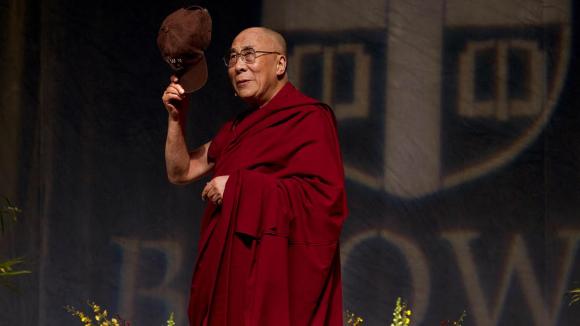PROVIDENCE, R.I. [Brown University] — Before His Holiness the Dalai Lama and thousands of Tibetan Buddhist monks and nuns Dec. 15, 2015, Brown University researcher Cathy Kerr will discuss the science of perception of body sensations. In her talk she will focus specifically on results by her lab and others that examine somatic attention, touch, and the perception of body and limb position in physical space.
Kerr will take the stage at the Sera Monastery in Bylakuppe, Karnataka, India, on the second day of the 30th Mind and Life Dialogue, “Perception, Concepts and Self: Contemporary Scientific and Buddhist Perspectives,” organized by the Mind and Life Institute and the Dalai Lama Trust. Though she is a senior fellow of the institute, Kerr, assistant professor (research) of family medicine and director of translational neuroscience in the contemplative studies initiative, has never met, much less shared the same spotlight, with the Dalai Lama before.
“I’m surprised and humbled,” Kerr said.
The conference will be streamed live. Kerr’s talk begins at 11:30 p.m. ET.
Brain and body
At Brown, Kerr and collaborators have performed several studies investigating the neuroscience underlying the effects of meditation. The work has shown how specific brainwave frequencies mediate the communication between brain regions that process body-focused attention and touch sensations and that experienced mindfulness meditators appear to gain conscious control over that process. Those results help to explain how meditators show such skill in focusing and shifting their attention toward or away from specific sensations or feelings and help scientists understand how the brain filters distractions.

“I’m really excited to get his feedback on all of this. You never know what he’s going to ask.”
Body sensations, including the sensation of touch, are a key ingredient in how we process our experience of the body in physical space. Neuroscientists refer to this embodied spatial self as the “bodily self,” Kerr said, and recent studies suggest the bodily self is a key contributor to our overall sense of self. In the second half of her hour-long presentation, Kerr said she will discuss research about how the brain integrates touch, a sense of muscle position, and visual perception of the body to compile a sense of the physical body’s presence in space.
“New discoveries over the last 10 years have told us a lot about how the brain integrates multiple sensory streams to produce this experience of the body in space,” Kerr said.
Neuroscientists, she will explain, have observed striking examples in multiple studies of how important the vision of the body can be. In the “rubber hand” illusion when one’s real hand is obscured from view by a mirror and a realistic rubber substitute is placed where the real one would be expected, many experimental subjects respond as if the rubber hand they can see is their own and the real hand they can’t see is not. Body temperature in the obscured real hand sometimes declines and immune system responses are slowed, Kerr said. Meanwhile, people will respond with reflexive fear (for instance with a galvanic skin response) of threats against the fake hand, as if it were theirs.
Scientists have even extended these effects to the full body by creating the illusion with a mannequin stand-in for the body below the neck, Kerr said.
Philosophy of perception
The evidence from the rubber hand illusion, Kerr said, is that the awareness of physical self is not merely concrete and corporeal, nor is it immutable. Instead it can be separated from the actual body. Consistent with the dually scientific and spiritual nature of the conference, she will discuss with the Dalai Lama and the audience some of the broader implications of what philosopher Thomas Metzinger calls “a second body.”
“The bodily self seems to sit intermediate between explicitly mental contents vs. explicitly physiological and material aspects of the body,” Kerr said.
Kerr notes that in certain mental disorders, such as schizophrenia and body dysmorphic disorder, the bodily self is perceived abnormally. She hypothesizes that it may also play a role in how people endure and recover from trauma.
“I think that studying the bodily self more closely may help us understand healing in a broad range of situations,” she said. “The data isn’t there yet, but it’s a very intriguing hypothesis.”
Kerr will begin a new study at The Miriam Hospital in March regarding how the contemplative practice Qigong may benefit cancer survivors.
The discussion in India is sure to raise questions, and Kerr said she’s been advised that the Dalai Lama’s inquiries can be far-ranging.
“I’m so excited and honored to represent our work at Brown to His Holiness,” she said. “I’m really excited to get his feedback on all of this. You never know what he’s going to ask.”

